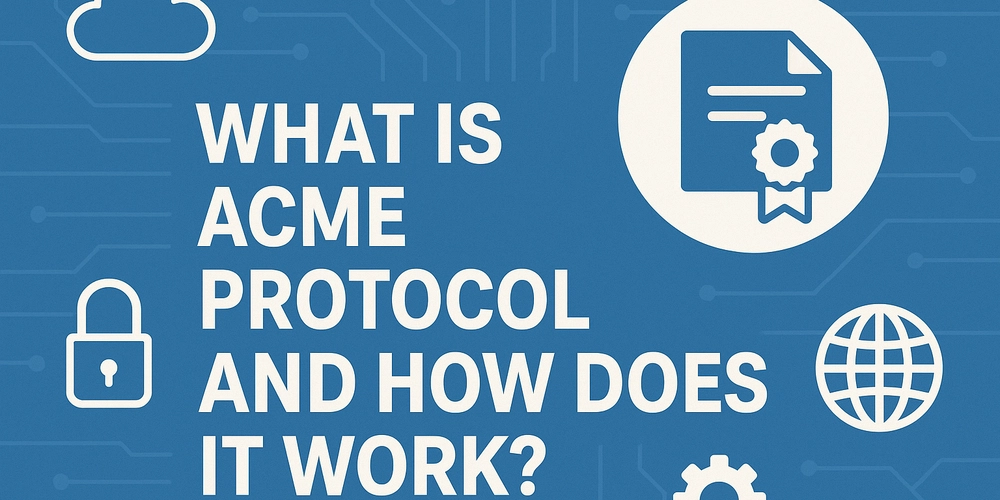What is ACME Protocol and How Does it Work?
You may encounter this message when you access a website online: “Your connection is not private.” Website security certificates expire, triggering such warnings. This minor oversight can cause a website’s reputation to suffer substantial damage, which can lead to distrustful behaviour from visitors. Website owners struggle with manual digital certificate administration, which presents significant management challenges. ACME Protocol emerged as an answer to automate certificate management processes. ACME functions as an Automatic Certificate Management Environment that controls SSL/TLS certificate issuance and renewal to simplify certificate management procedures. This article will explore the ACME Protocol, how it works, and the key advantages it offers for automating SSL/TLS certificate management. What is the Acme Protocol? The Automated Certificate Management Environment Protocol (ACME) functions as an essential tool for automatic PKI systems certificate management. The protocol enables smooth data transfer between Certificate Authorities through endpoints. Other protocols do not match the cost-free nature of ACME since it does not require licensing expenses, and its configuration process remains straightforward. Organisation security is strengthened through the implementation of this protocol by IT teams. RFC 8555 received publication as an Internet Standard by the Internet Security Research Group (ISRG) for its ACME protocol. The ACME v2 API constitutes the present protocol version that appeared in March 2018 following the deprecation of the earlier version (ACME v1) in April 2016. How Does Acme Protocol Work The ACME protocol sets up communication channels between ACME servers and their matching clients. The following sequence normally presents itself at each stage of the process: Account Creation The ACME client starts through account registration with the Certification Authority. The process requires users to produce their private key while sharing its linked public key with the CA to verify their identity. The account gets connected to the key during the CA registration process so the account can verify certificate requests at a later stage. Domain Ownership Validation The CA implements ACME challenges as an authentication method to establish domain control. The certificate issuance process depends on correctly resolving the ACME challenge before the authority proceeds. Three types of ACME challenges exist at present. Challenge 1 – HTTP-01 In this challenge, the CA requests that a specific file be hosted at a predefined URL on the domain via HTTP (port 80). The ACME client must serve the file with the correct token and thumbprint of the authorisation key in the file’s contents. Once the CA retrieves the file and validates it, domain ownership is confirmed. Challenge 2 – DNS-01 Through this challenge the CA wants a particular file to reside at a designated URL reachable through HTTP (port 80) protocol. The ACME client needs to provide the correct token and thumbprint from the authorisation key within the file contents that the server serves. The CA verifies domain ownership by obtaining the file, which undergoes approval validation. Challenge 3 – TLS-ALPN-01 The ACME client uses an ALPN extension to establish a temporary TLS certificate connection through port 443. The authentication process requires the CA to check both server domain ownership together with certificate validation. Certificate Issuance The ACME client proceeds to transmit the certificate signing request (CSR) to the requesting CA after validating the domain. The CA system creates an SSL/TLS certificate, after which it provides it to clients for download. Certificate Installation and Renewal The ACME client performs automatic certificate installation on the server and periodically renews it before its expiration, ensuring uninterrupted HTTPS functionality. Certificate Revocation (Optional) When certificates become compromised or no longer required, the ACME client has a secure method to request revocation to the CA. What Are the Benefits of ACME Protocols? The ACME Protocol has made it easier for organisations to manage digital certificates by automating the process and reducing errors. It helps improve security and makes operations more efficient. 1. Automation The most crucial advantage of ACME lies in its automation features. The automated system runs certificate operations like certificate issuance, installation and renewal, is handled without human involvement and ensures that certificates remain always updated. 2. Cost-Effective ACME provides an excellent web security solution to businesses seeking protection with minimal financial impact. The system meets all requirements by offering additional features and enhanced assurance at different assurance levels according to user-specific needs

You may encounter this message when you access a website online: “Your connection is not private.” Website security certificates expire, triggering such warnings. This minor oversight can cause a website’s reputation to suffer substantial damage, which can lead to distrustful behaviour from visitors.
Website owners struggle with manual digital certificate administration, which presents significant management challenges. ACME Protocol emerged as an answer to automate certificate management processes.
ACME functions as an Automatic Certificate Management Environment that controls SSL/TLS certificate issuance and renewal to simplify certificate management procedures.
This article will explore the ACME Protocol, how it works, and the key advantages it offers for automating SSL/TLS certificate management.
What is the Acme Protocol?
The Automated Certificate Management Environment Protocol (ACME) functions as an essential tool for automatic PKI systems certificate management. The protocol enables smooth data transfer between Certificate Authorities through endpoints. Other protocols do not match the cost-free nature of ACME since it does not require licensing expenses, and its configuration process remains straightforward. Organisation security is strengthened through the implementation of this protocol by IT teams.
RFC 8555 received publication as an Internet Standard by the Internet Security Research Group (ISRG) for its ACME protocol. The ACME v2 API constitutes the present protocol version that appeared in March 2018 following the deprecation of the earlier version (ACME v1) in April 2016.
How Does Acme Protocol Work
The ACME protocol sets up communication channels between ACME servers and their matching clients. The following sequence normally presents itself at each stage of the process:
Account Creation
The ACME client starts through account registration with the Certification Authority. The process requires users to produce their private key while sharing its linked public key with the CA to verify their identity. The account gets connected to the key during the CA registration process so the account can verify certificate requests at a later stage.
Domain Ownership Validation
The CA implements ACME challenges as an authentication method to establish domain control. The certificate issuance process depends on correctly resolving the ACME challenge before the authority proceeds. Three types of ACME challenges exist at present.
Challenge 1 – HTTP-01
In this challenge, the CA requests that a specific file be hosted at a predefined URL on the domain via HTTP (port 80). The ACME client must serve the file with the correct token and thumbprint of the authorisation key in the file’s contents. Once the CA retrieves the file and validates it, domain ownership is confirmed.
Challenge 2 – DNS-01
Through this challenge the CA wants a particular file to reside at a designated URL reachable through HTTP (port 80) protocol. The ACME client needs to provide the correct token and thumbprint from the authorisation key within the file contents that the server serves. The CA verifies domain ownership by obtaining the file, which undergoes approval validation.
Challenge 3 – TLS-ALPN-01
The ACME client uses an ALPN extension to establish a temporary TLS certificate connection through port 443. The authentication process requires the CA to check both server domain ownership together with certificate validation.
Certificate Issuance
The ACME client proceeds to transmit the certificate signing request (CSR) to the requesting CA after validating the domain. The CA system creates an SSL/TLS certificate, after which it provides it to clients for download.
Certificate Installation and Renewal
The ACME client performs automatic certificate installation on the server and periodically renews it before its expiration, ensuring uninterrupted HTTPS functionality.
Certificate Revocation (Optional)
When certificates become compromised or no longer required, the ACME client has a secure method to request revocation to the CA.
What Are the Benefits of ACME Protocols?
The ACME Protocol has made it easier for organisations to manage digital certificates by automating the process and reducing errors. It helps improve security and makes operations more efficient.
1. Automation
The most crucial advantage of ACME lies in its automation features. The automated system runs certificate operations like certificate issuance, installation and renewal, is handled without human involvement and ensures that certificates remain always updated.
2. Cost-Effective
ACME provides an excellent web security solution to businesses seeking protection with minimal financial impact. The system meets all requirements by offering additional features and enhanced assurance at different assurance levels according to user-specific needs.
3. Improved Security
ACME automation reduces renewal time to minimise site vulnerabilities that can occur from expired certificates.
4. Scalability
ACME is the best choice for managing many certificates in large websites and enterprise systems, making the process simple and efficient.
5. Time-Saving
The system automates all certificate management stages, starting from the request phase through to renewal.
For a step-by-step guide on setting up ACME client configurations, refer to this article.
Conclusion
Digital certificate management becomes less complicated through the ACME Protocol, which automates tasks extending to issuance, renewal and installation. The automated process shortens manual labour requirements while decreasing human error possibilities and strengthening security measures. ACME provides organisations with scalability and cost efficiency that enables secure management of SSL/TLS and HTTP connections in a simplified manner.




















_Andy_Dean_Photography_Alamy.jpg?width=1280&auto=webp&quality=80&disable=upscale#)





















































